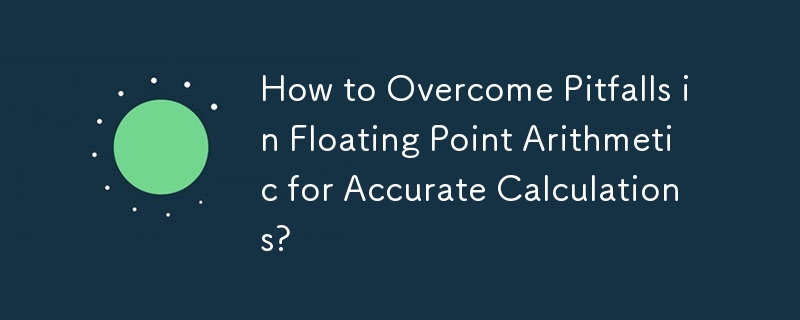 Backend Development
Backend Development
 Python Tutorial
Python Tutorial
 How to Overcome Pitfalls in Floating Point Arithmetic for Accurate Calculations?
How to Overcome Pitfalls in Floating Point Arithmetic for Accurate Calculations?
How to Overcome Pitfalls in Floating Point Arithmetic for Accurate Calculations?

Floating Point Arithmetic Pitfalls: How to Overcome Them
Decimal-based floating-point arithmetic, commonly used in programming languages like Python, can introduce subtle errors due to its approximate nature. Understanding these errors is crucial for accurate calculations.
The Issue
Consider the following Python function for estimating square roots using floating-point addition:
1 2 3 4 5 |
|
This function, however, produces imprecise results:
1 2 3 4 |
|
The Problem with Floating Point
The issue lies in the fact that Python's floating-point values are not exact representations of decimal numbers. Instead, they use binary representation, which can lead to inaccuracies when dealing with numbers that cannot be precisely represented in binary form.
In the example function, the addition of 0.01 is not equivalent to adding 1/100 due to this approximate representation. The actual value added is slightly larger than 1/100, leading to a slight overestimation.
Overcoming Floating Point Errors
To avoid these errors, consider the following strategies:
- Use Decimal Module:
The Python decimal module provides an alternative type, Decimal, that uses a fixed-point representation based on decimals. This offers more precise calculations, as seen in the modified function:
1 2 3 4 5 6 7 |
|
- Use Binary Representable Values:
Stick to floating-point additions that represent exact binary fractions, such as 0.125 (1/8) or 0.0625 (1/16). This ensures that additions are precise without introducing rounding errors.
Understanding and overcoming floating-point errors is essential for accurate numerical calculations. By employing appropriate strategies, developers can minimize these errors and achieve more precise results.
The above is the detailed content of How to Overcome Pitfalls in Floating Point Arithmetic for Accurate Calculations?. For more information, please follow other related articles on the PHP Chinese website!

Hot AI Tools

Undresser.AI Undress
AI-powered app for creating realistic nude photos

AI Clothes Remover
Online AI tool for removing clothes from photos.

Undress AI Tool
Undress images for free

Clothoff.io
AI clothes remover

AI Hentai Generator
Generate AI Hentai for free.

Hot Article

Hot Tools

Notepad++7.3.1
Easy-to-use and free code editor

SublimeText3 Chinese version
Chinese version, very easy to use

Zend Studio 13.0.1
Powerful PHP integrated development environment

Dreamweaver CS6
Visual web development tools

SublimeText3 Mac version
God-level code editing software (SublimeText3)

Hot Topics
 How to Use Python to Find the Zipf Distribution of a Text File
Mar 05, 2025 am 09:58 AM
How to Use Python to Find the Zipf Distribution of a Text File
Mar 05, 2025 am 09:58 AM
How to Use Python to Find the Zipf Distribution of a Text File
 How Do I Use Beautiful Soup to Parse HTML?
Mar 10, 2025 pm 06:54 PM
How Do I Use Beautiful Soup to Parse HTML?
Mar 10, 2025 pm 06:54 PM
How Do I Use Beautiful Soup to Parse HTML?
 How to Work With PDF Documents Using Python
Mar 02, 2025 am 09:54 AM
How to Work With PDF Documents Using Python
Mar 02, 2025 am 09:54 AM
How to Work With PDF Documents Using Python
 How to Cache Using Redis in Django Applications
Mar 02, 2025 am 10:10 AM
How to Cache Using Redis in Django Applications
Mar 02, 2025 am 10:10 AM
How to Cache Using Redis in Django Applications
 Introducing the Natural Language Toolkit (NLTK)
Mar 01, 2025 am 10:05 AM
Introducing the Natural Language Toolkit (NLTK)
Mar 01, 2025 am 10:05 AM
Introducing the Natural Language Toolkit (NLTK)
 How to Perform Deep Learning with TensorFlow or PyTorch?
Mar 10, 2025 pm 06:52 PM
How to Perform Deep Learning with TensorFlow or PyTorch?
Mar 10, 2025 pm 06:52 PM
How to Perform Deep Learning with TensorFlow or PyTorch?







